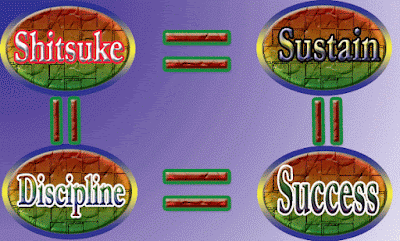In 5S
System achieving the 1st 4our S;
Seiri or
Sorting, Seiton
or Set in order, Seiso
or Shining & Seiketsu
or Standardizing is comparatively easy than the 5th S; Shitsuke. Shitsuke is the 5th and the final step of the 5S method. It means “Sustain” or
“Sustained discipline”, or “Sustaining through discipline”.
Maintaining exact discipline in the workstation so that all rules and
actions distinct from the first, next, third and fourth S are followed until
they are enhanced, the fifth S of 5S,
actual meaning in Japanese is “Discipline”.
It is a Japanese
word that carries an asset of culturing importance:
Discipline and training compulsory upon a person:
Children are trained by their parents to brush their teeth after each
meal.
Self-discipline:
Children grow into adults who brush their teeth after each meal.
Shared cultural self-discipline:
Everyone is expected to brush their teeth after each meal.
Personal discipline to continually practice and improve:
Golfers follow putts and drives - they do not merely play one round on
the weekend without practicing in between.
The responsibility for Shitsuke is shared between management and the workforce.
Managers should remind the employees of the 5S ethics, and support them through
regular messages and behaviors.
In the Japanese language the 5th S – Shitsuke
is written as:
躾
The final stage is 5S - Shitsuke
or Sustain, ensuring that the company continues to continually progress using
the previous stage of 5S. Keep up
housekeeping, and accomplish audits and so onward.
5S
should become part of the culture of the business and the liability of everyone
in the organization.
In the first four methods of 5S Series, we have been looking at the heredity of 5S practices. Shitsuke is typically
written with Japanese hiragana syllables rather than the kanji characters consequent
from Chinese. The kanji has the symbol
for “body, self, soul or mind” on the left side, and the symbol for “beauty” on
the right. It means “self-discipline,” or internalized, self-motivated
discipline. Discipline from the outside should step by step and naturally
transform into self-discipline as a person matures. A Discipline, then becomes
a continuous practice or a state of being.
5S has
some principles. Such as:
1.
Introduce and support audit and certification
programs, to formally ensure that the new standards are sustained and
implemented.
2.
Develop Seiketsu (Standardized Cleanup)
procedures and appraisal the criteria from time to time Conduct inspections to
ensure the standards are met.
3.
Devote time and resources to the less-frequent
cleanups.
4.
Provide training, storage space, cleaning
supplies replacement parts and other resources as required to enable the
standards to be met.
6.
Communicate the 5S principles to the workers on a regular
basis-perhaps by installing and updating posters that emphasize one or another
aspect of the 5S
program.
Visual Communication:
Communicating with other’s or understanding
to someone is not an easy process. Here, sometimes language is not enough to understand
anything. Guess, in a garments industry sewing floor, there in front of the
machine a notice is hanged. Where a safety instruction says, “sit in your chair
for working from the 2 inch away of machine.” The sentence itself is clear, but
everyone has not a sense of 2 inches. Therefore, if there a visual explanation
and notice, a tape marking is located on the floor 2 inches from the machine,
letting everyone know what areas are unsafe. Communication discipline means
using language that is clear, and checking that people have understood properly.
It means using visual communication as well as verbal.
Leaders Behavior:
Leaders behavior
should be a role model for the others. In Japan, after the earthquake of Stunami,
Prime Minister Kon and the members of the Japanese cabinet changed from their
usual business suits to the work uniforms usually seen in factories. This expressed
their determination to work to get the situation under control. Government spokesman
Yukio Edano gave a statement in the television was an apparent constant state of
exhaustion. Similarly, in a Japanese workplace, everyone, even executive are
expected to pull together and do what needs to be done in an emergency.
Self Control or Composure:
During the critical
moment, bars and restaurants saw a severe drop in their business. Even Japanese
who were not directly affected felt that they couldn’t feel good about themselves
while others were suffering. Most people practicing voluntary as controlled
from the buying of staples such as toilet paper, even though many were anxious
about those items becoming short supply.
Shitsuke means that once procedures
and approaches are affected, workers voluntarily carry out the 5S activities without having to be noticed. It should
not be necessary to reward workers to perform their assigned tasks, or discipline
workers for not doing them. Workers should continue to practice the activities
even after moving to different workstations. Shitsuke
means not just following the rules, but exhausting the common sense to
recognize and react properly to 5S encounters.
It means using your Brain.
Md. Farid Ahmed
IE Officer
Fakir Apparels Ltd.
BSCIC Industrial Area, Enayet Nagar,
Fatulla, Narayangonj, Bangladesh.
Mobile: 8801814220987
E-mail: farid.ieconcern@gmail.com
IE Officer
Fakir Apparels Ltd.
BSCIC Industrial Area, Enayet Nagar,
Fatulla, Narayangonj, Bangladesh.
Mobile: 8801814220987
E-mail: farid.ieconcern@gmail.com


No comments:
Post a Comment